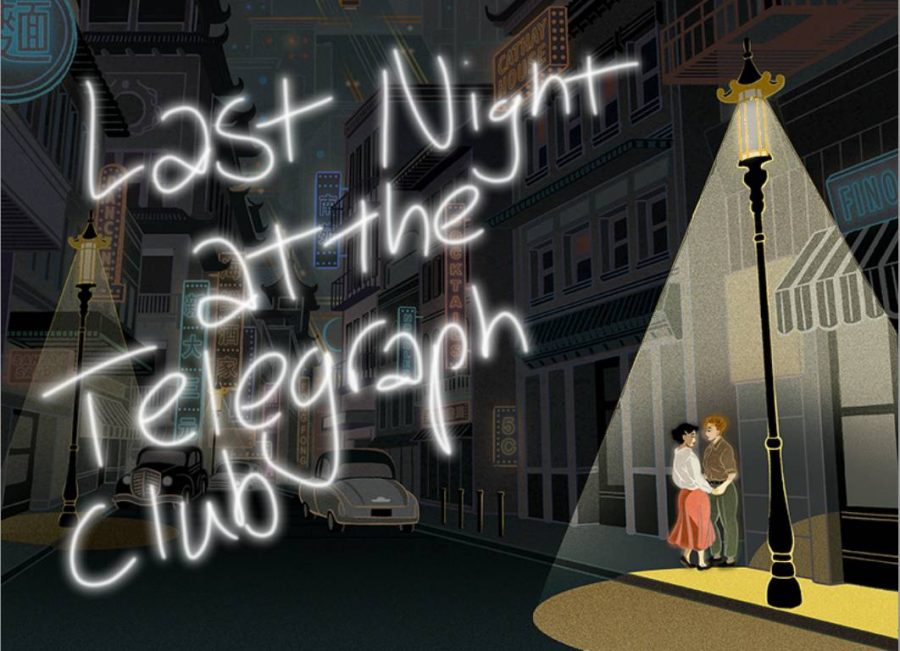Warning: This article contains spoilers for the book “Last Night at the Telegraph Club” by Malinda Lo and contains mentions of homophobia and alcohol. Reader discretion is advised.
Identity. Relationships. Familial expectations. Everyone has to deal with them at one point or another. For most LGBTQ+ people of color, these topics come up every day, often accompanied by tension and other struggles.
Malinda Lo’s “Last Night at the Telegraph Club” portrays these struggles through the eyes of Lily Hu, a 17-year-old Chinese American lesbian living in San Francisco’s Chinatown in the 1950s. This book leads the reader through much of Lily’s senior year of high school, explaining her experience with coming to terms with her identity and defying her family’s expectations. It centers around events in a nightclub called the Telegraph Club and Lily’s observations of her life surrounding these events.
As someone who identifies as bisexual and Korean American, this book hit especially close to home. I saw some of my worst fears and most vivid hopes play out as I read. It put into perspective just how lucky I am and how much times have changed. Lily has to sneak around and hide her sexual orientation; I can easily come out without as much fear. She lives in a time when hoping to be a female scientist was only that: a hope. I know many people who expect to go into STEM-related careers, which pertain to science, technology, engineering, and math. I could name other contrasts, but we would be here for hours.
“Last Night at the Telegraph Club” deals with themes pertaining to teenage life, romantic relationships and identity, race, and careers. Lily regularly deals with comments about her race and sexual orientation, both directly and indirectly. In addition to the normal struggles of high school, these comments and her experiences only pile onto the pressure she faces in life. Lily is only one of two girls in her math class, the other being Kathleen Miller, for whom she eventually develops feelings. Her friend, Shirley Lum, is hot and cold about their relationship, constantly starting arguments and never asking for forgiveness, but still associating with Lily when she pleases. She ostracizes Lily for the most trivial things, but Kathleen’s presence is the tipping point in their friendship. Lily eventually forms a relationship with Kathleen, cementing the fate of her now severed friendship with Shirley.
It was clear early in the story that Shirley was homophobic. She was also quite hypocritical, behaving in ways that her community disapproved of but still judging Lily for something she could not control. I found her to be annoying at best but downright horrible at worst. She was controlling and a bully, to put it simply, excluding and including Lily based on her fleeting whims. Shirley’s close-mindedness and general attitude about friendship made her extremely dislikeable. The worst part of her behavior was her “explanation” to Lily’s mother about the whole situation. She had no right or even reason to do so, but it only heightened the tension in Lily’s family, exacerbating the entire situation. I didn’t like how she came to talk after Lily had run away from home. It felt underhanded and wrong; she seemed to take advantage of Lily’s plight. Watching the friendship unravel was dissatisfying, but it led to strong character development for them: Shirley grew into the main antagonist role, and Lily’s handling of hardships gave her more complexity.
In contrast, I found that the women that Lily and Kathleen met at the Telegraph Club were pretty cool. All of them had some level of courage to come to the club, especially knowing that the club could be raided and shut down at any moment. I found Lily’s observations of the intricacies of their relationships to be fascinating, even though her state of intoxication could make her an unreliable narrator. Shirley repeatedly emphasizes that Lily is “oblivious,” but it is clear that she is not, simply based on her observations at the club. Through these observations, Lily developed as a character, beginning to accept her identity, and it gave insight into the culture of the LGBTQ+ community of the time.
I found it interesting how Lo incorporated chapters from the perspectives of Lily’s parents and aunt. It was clear that they were meant to explain her family’s attitudes about life, but I think they could have been written slightly better. At times, a few of the scenes seemed out of place. They had no bearing on character development and were never mentioned again or resolved at the end of the book when Lily moved away. Otherwise, I thought these chapters were a nice touch. They helped explain a little bit about Lily’s family and their connections and insight into the influences that shaped their perspectives on the world.
As for the story itself, I really enjoyed it. Everyone has their own story, and Lily was no different. She grew from a modest, almost timid girl into a confident, brave young woman. She gained courage as she explored her identity, which made for a wonderful story. Tackling themes of politics and racial identity in addition to sexual orientation, the scenes all fit like puzzle pieces to depict the hardships and happiness of the 1950s. Lo strung each scene together smoothly to create the serenity that is “Last Night at the Telegraph Club.”
I genuinely enjoyed this book. Since it is Asian Pacific American Heritage Month, I recommend this book to anyone interested in Asian American Pacific Islander (AAPI) content. There is language and a few scenes that some may find disturbing, so I would advise reader discretion. Otherwise, this was an amazing book, with a great plot and complex characters, and I loved it. It deserves 5/5 stars, and I would love to read more of Lo’s work.













